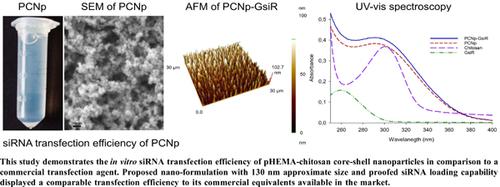Current Nanoscience ( IF 1.5 ) Pub Date : 2020-11-30 , DOI: 10.2174/1573413716666200110093715 Erdal Eroğlu 1 , Hüseyin Saygın Portakal 1 , Ayşenur Pamukçu 1

|
Background: Despite great hopes for small interfering RNA (siRNA)-based gene therapies, restrictions, including the presence of nucleases, reticuloendothelial system and undesired electrostatic interactions between nucleic acids and the cell membrane, limit the success of these approaches. In the last few decades, non-viral nucleic acid delivery vectors in nanosize with high biocompatibility, low toxicity and proton sponge effect have emerged as magic bullets to overcome these drawbacks.
Objective: This study aimed to develop poly(2-hydroxyethyl methacrylate) (pHEMA)-chitosan nanoparticles (PCNp), and to transfect green fluorescent protein (GFP)-silencing siRNA (GsiR) in vitro.
Methods: Firstly, PCNp displaying core-shell structure were synthesized and thereafter GsiR was encapsulated into the core of PCNp. The synthesized PCNp with/without GsiR were characterized using ultraviolet-visible (UV-vis)-spectroscopy, Fourier-transform infrared (FTIR) spectroscopy, thermal decomposition, atomic force microscopy (AFM), scanning electron microscopy (SEM), zeta potential and dynamic light scattering (DLS) measurements. Encapsulation of siRNA into the pHEMA core coated with chitosan shell was demonstrated using fluorescence and FTIR spectroscopy.
Results: The surface charges of PCNp and PCNp-GsiR were found to be +39.5 and +40.2, respectively. In DLS analysis, an insignificant shift in the Z-average diameter of PCNp was observed from 109 nm to 133 nm using the encapsulation of GsiR. In comparison to other studied nanomaterials and a commercial transfection reagent, our findings suggest a promising GFP-silencing effect of 45%.
Conclusion: To our knowledge, we have obtained comparable silencing activity with the other studied equivalents despite using the lowest concentration of siRNA in existing literature.
中文翻译:

新一代纳米疗法:siRNA递送中的pHEMA-壳聚糖纳米复合材料
背景:尽管对基于小干扰RNA(siRNA)的基因疗法寄予厚望,但限制因素(包括核酸酶,网状内皮系统的存在以及核酸与细胞膜之间不希望的静电相互作用)限制了这些方法的成功。在过去的几十年中,具有高生物相容性,低毒性和质子海绵效应的纳米级非病毒核酸递送载体已经成为克服这些缺点的灵丹妙药。
目的:本研究旨在开发聚甲基丙烯酸2-羟乙酯(pHEMA)-壳聚糖纳米颗粒(PCNp),并在体外转染绿色荧光蛋白(GFP)-沉默siRNA(GsiR)。
方法:首先合成具有核-壳结构的PCNp,然后将GsiR封装到PCNp的核中。使用紫外-可见(UV-vis)光谱,傅立叶变换红外(FTIR)光谱,热分解,原子力显微镜(AFM),扫描电子显微镜(SEM),ζ电势和动态光散射(DLS)测量。使用荧光和FTIR光谱证明了将siRNA包封到壳聚糖外壳包裹的pHEMA核中。
结果:PCNp和PCNp-GsiR的表面电荷分别为+39.5和+40.2。在DLS分析中,使用GsiR封装观察到PCNp的Z平均直径从109 nm到133 nm发生了微小变化。与其他研究的纳米材料和商业转染试剂相比,我们的发现表明,GFP沉默效果有望达到45%。
结论:据我们所知,尽管使用现有文献中最低的siRNA浓度,我们仍获得了与其他研究等效物相当的沉默活性。

























 京公网安备 11010802027423号
京公网安备 11010802027423号